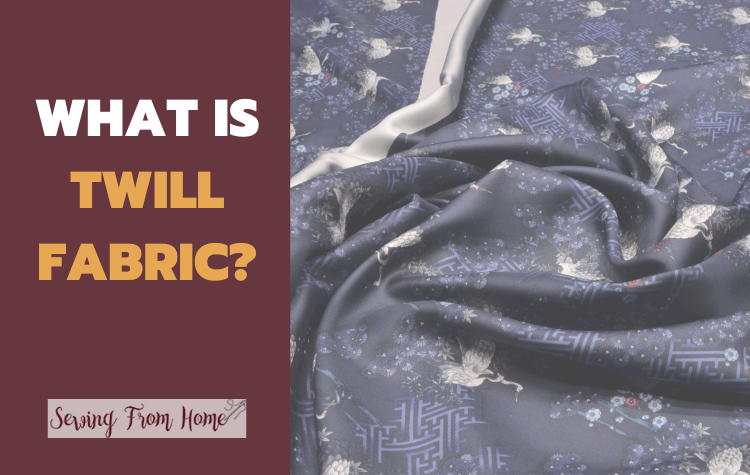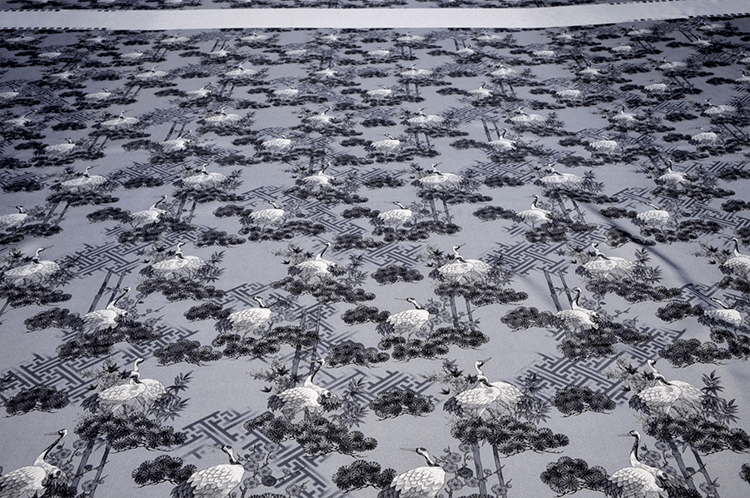Browsing through a fabric store is delightful. But it can get pretty confusing if you’re looking at fabrics; cotton, polyester, and wool are all labeled as twill. What is twill fabric?
Twill is a style of textile weaving where the weft thread is woven over and under one or more warp threads, creating a closely woven fabric with a diagonal rib pattern. Twill is made from cotton, wool, silk, polyester, or a blend. It produces durable, sturdy fabric ideal for clothing and home uses.
It’s odd to think that a business suit, a nurse’s uniform, and a winter overcoat can all be made from twill. Let’s look at this versatile fabric, what it’s made of, and its uses.
What Is Twill?

Twill is a versatile fabric, defined not by the fibers it’s made from (like cotton or linen) but by the pattern of the weave. Fabric can be described as twill if the warp threads are staggered, creating diagonal ribs or textural lines.
To create this zig-zag pattern, the weft or horizontal thread is woven over and under one or more warp or vertical threads. The diagonal pattern develops as each row is offset from the one above.
Twill is categorized by the number of threads the weft has been woven over and under. For example, a 3/1 twill has the weft thread woven over three and under one warp thread.
The threads create different patterns, including diaper twill (with diamond shapes), broken or alternating twill, and elongated twill.
The unusual twill weave can be highlighted through multiple colored yarns to create twill designs like houndstooth or herringbone.
Twill’s weave is distinctly tight, with a high thread count. Depending on the thread count and fiber, twill can be soft and drapey or thick, durable, and able to hide stains well.
Everyday items made from twill are jeans, chinos, suits, bedding, towels, bags, and upholstery.
When Was Twill First Made?
Twill is an ancient style of textile weave, along with satin and plain weaves, and dates back hundreds of years.
Serge, a variety of twill, was found in China as early as the eighth century and was made from silk.
The name “twill” was first used in the fourteenth century and comes from the Old English “twili,” which means having a double thread. Woolen twill is commonly associated with British culture, especially in the form of tweed.
As cotton became cheaper in the eighteenth and nineteenth centuries, cotton twill became more common. Polyester twill appeared in the twentieth century.
What Is Twill Made Of?
Because twill refers to the style of weaving rather than the material, twill can be made from different fibers. Natural twill uses cotton, wool, or silk, while synthetic twill is made from polyester and polyester blends. The fiber will influence how the twill drapes, how warm and durable it is, and what you can make with it.
Let’s look at some common variations of twill.
Twill Made From 100% Cotton
Cotton twill is cotton woven with a twill weaving pattern and is one of the most popular twill fibers. Here are some varieties of cotton twill.
Denim
Denim is the most famous version of cotton twill, made into millions of pairs of blue jeans annually. Denim is instantly recognizable as the fabric is dyed on the warp – the weft is left a lighter color.
Created as a heavy fabric for durable work clothes, denim is now a fashionable fabric, made in various weights.
Chino
The high-quality cotton used to make chinos or khakis is a smooth, medium-weight variety of cotton twill. The typical colors of this fabric are light brown and tan, as the material is ideal for summer wear.
Gabardine
Gabardine is a particularly densely woven twill with small diagonal ribs on one side, creating a slight sheen. It is usually made of cotton, but luxury gabardine can be made from wool, silk, or a blend of the three.
Gabardine was created by the founder of the Burberry brand, Thomas Burberry, in the late nineteenth century, for jackets, coats, and suits. The fabric drapes well and is crease-free.
Cotton Drill
Cotton drill is made from coarse cotton yarn, creating a durable, sturdy canvas-like fabric. Despite its weight, cotton drill has the usual diagonal twill pattern.
Drill is handy for household uses, such as upholstery and curtaining, as it is hard-wearing, doesn’t show dirt easily, and won’t retain odors.
Flannel
A ubiquitous winter fabric, flannel’s bright plaid pattern, warmth, and napped softness makes shirts, jackets, pajamas, and coat linings. Suit-quality flannel is heavier but equally warm.
The warmth comes from the slightly looser weave, which allows air to be caught in the spaces and creates insulation.
Twill Made From Silk
Silk twill is light, with a beautiful drape that absorbs dye readily. The softness and vivid colors make silk twill ideal for shirts, blouses, evening dresses, scarves, and lingerie.
The fabric ranges from very light-weight to medium-weight, depending on the heaviness of the threads.

Foulard
Foulard is a very light twill, usually made from silk or a silk-cotton blend. The fabric is characterized by a repeated block pattern originating in the Far East.
Surah
Surah refers to a so-called balanced twill weave, meaning you can see the diagonal pattern on both sides of the fabric.
Silk surah twill was sought-after in the eighteenth century when it was used for dresses and coats. It is still used today for ties, scarves, and lingerie.
Twill Made From Wool
Wool twill is wonderfully warm and cozy, making it a favorite for winter clothes and soft furnishings. This fabric is also ideal for suiting, as it is stain-resistant, durable, and elegant.
There are several types of wool twill.
Tweed
The iconic British fabric originated in Scotland, where it was called “tweel,” Scots for twill. A misunderstanding by English tailors conflated the name with the River Tweed, coining the term for rugged, woolen suiting associated with country estates.
Various tweed patterns, including Harris Tweed, overcheck twill, and barleycorn tweed, use different colored threads to create texture. Names for tweed also depend on where it is made and even the sheep which provide the wool.
Herringbone Twill
Herringbone is a variety of twill that uses different colored weft and warp threads to create the typical staggered pattern. Herringbone tweed is a famous use of the herringbone pattern.
Diamond Twill
Another twill pattern, commonly seen in woolen rugs, is diamond twill. The woven threads create a series of parallel diamonds with multiple concentric lines.
Houndstooth
Another popular suiting fabric, houndstooth fabric, has a checkered design created by alternating bands of four dark and four white threads, with the diagonal stagger looking like teeth.
Houndstooth is made in many colors and is used for shirts, dresses, outerwear, and purses.
Serge
Although serge was initially made from silk, the fabric is now typically wool or wool-blend. Serge is hardy and warm, often used for military uniforms, coats, and suits. Silk serge is reserved for the lining of these coats.
Cavalry Twill
The name of this fabric indicates its origins, being used for military uniforms, riding breeches, heavy overcoats, and smart trousers.
Typically tan or khaki-colored, cavalry twill is also recognizable for its double diagonal weave. Wool cavalry twill is durable and heavy, while a cotton variety is equally sturdy but less warm.
Twill Made From Polyester
Polyester twill is made from synthetic fibers and has a silky, soft texture that wicks moisture away from the body and dries quickly.
Because it’s made of polyester, it doesn’t shrink or stretch but lacks breathability. Polyester twill is therefore ideal for tablecloths, aprons, and uniforms.
The main advantage of polyester twill is that it’s cheaper than twill made from natural fibers and can replicate cotton, silk, and wool twills at budget prices. You can therefore find polyester chino, polyester surah, etc.
Polyester-Cotton Twill Blend
Adding cotton to a polyester twill means the fabric is more comfortable, absorbent, and breathable. It remains crease-resistant and easy to iron.
What Is Twill Used For?
Because of the variety of weights, patterns, and fibers twill is made in, it is a very versatile fabric. Here are some common uses of twill.
Twill Is Used For Clothing
Because twill is durable, hard-wearing, crease-resistant, and unlikely to show stains, it is ideal for making clothing.
- Denim is a famous example of twill being used for clothing as denim jeans and jackets are worn year-round.
- Chinos or chino trousers are another common clothing item made from twill.
- Many varieties of twill are used for suiting, especially gabardine, tweed, and serge.
- Uniforms, work overalls, and industrial jumpsuits are often made of twill, whether from wool, cotton, or polyester, as it is comfortable, durable, and washable.
- Heavy-weight wool and cotton twill make warm overcoats, jackets, and other winter items.
- Light-weight cotton and silk twills are ideal for dresses, ties, lingerie, shirts, blouses, and dresses.
Twill In The Home
Twill is handy for soft furnishings and upholstery as it is durable but drapes and ages beautifully.
- Sofas and armchairs are often covered with twill, whether cotton drill, wool, or polyester blends. This fabric is excellent for families with pets and children as it is hard-wearing and doesn’t show dirt.
- Cushions, curtains, and tablecloths made from twill last for years and stand up to repeated washing.
- Luxury bed linen, including sheets, blankets, and duvet coveres, is often made from high thread-count cotton, so it is soft and wears well.
- Bath towels are commonly produced using cotton twill.
- Wool twill, such as diamond twill, is a standard fabric for rugs, carpets, and wall hangings.
How To Sew With Twill
Once you have the supplies, sewing with twill is a pleasure as there are many projects you can undertake. However, there are a couple of issues around working with twill:
- Prewash twill before sewing. Cotton twill, in particular, can shrink up to 5% after the first wash. Polyester twill won’t shrink at all.
- The weave means that twill can fray badly. Use a welt seam, felled seam, or another fully enclosed seam for lighter twill and pinking shears for heavier twill seams.
- Twill has nap or directionality, so be clear on which side of the fabric you’re working with and where the grain of the material lies.
- Always use very sharp needles, with a size between 70 and 90, depending on the twill’s thickness.
Our Verdict on Twill Fabric
Twill’s versatility makes it a helpful fabric with many applications. Depending on the fiber, this diagonally-ribbed fabric can be used for most clothing and home products.
